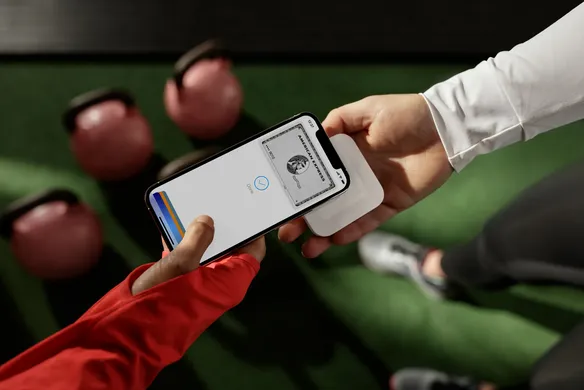Table of contents
You’re probably accepting payments with card readers on a daily basis. But do you know what actually happens when your customers tap, insert and swipe their cards? It’s an amazing process, with many detailed and intricate steps.
To let you in on the process, we thought we’d spend a few minutes explaining the innovative technology behind our Square Reader.
How do credit card readers work?
Credit card readers read your customer’s card information and securely communicate the transaction data to the bank and the credit card network. Whether you’re accepting eftpos payments with a traditional EFTPOS (or electronic funds transfer at point of sale) terminal or a newer, more advanced mobile card reader, it’s helpful to understand the payment processing flow.
Credit card processing explained
There are three defined stages for processing a credit card with Square: authorisation, capture and settlement. Here’s how the stages work:
Step 1: Authorisation
When you tap, insert or swipe your customer’s card, the payment request is sent to Square. We then pass the transaction information through to the financial institution (sometimes known as a merchant bank or acquiring bank). This bank acts as the go-between and sends the request to the issuing bank (the company that issued the customer’s card). The issuing bank then checks if your customer has enough credit for the transaction and uses fraud detection software to check the legitimacy of the transaction. If all the checks are approved, the transaction is authorised and a hold placed on the funds, which shows up as “pending” on your customer’s statement.
Step 2: Capture
Next, funds are moved from the credit card company to the acquiring bank. This function is known as “batching” when a large group of payments is moved in one big batch.
Step 3: Settlement
This is the step we all love — payday! Funds from the transaction are settled through Square’s system and deposited into your bank account. Most Square sellers receive their funds within 24 hours, depending on your bank. If you’d prefer, Square’s handy Scheduled Deposit feature gives you the ability to schedule a set time every day for your deposit to be processed to your bank. This can help immensely should your business need support with timely management of cash flow.
The next question is, how do the actual card readers work? We’ve split this out into chip card (also known as EMV) readers, and contactless (also known as NFC) readers, to make things simple.
How chip (EMV) card readers work
EMV®, developed and managed by American Express, Discover, JCB, Mastercard, UnionPay and Visa, is the global standard for chip cards. While Australia made the migration to EMV in 2013, there are still some markets around the world (like the U.S., for example) which are still undergoing the migration from magstripe to chip.
Chip cards are considered some of the most secure cards, because the data on them is dynamically encrypted, making it very difficult for fraudsters to isolate the cardholder data and extract it into anything that could be used illegally. EMV technology has been proven to help fight and reduce fraud in countries around the world, and the countries that have already made the switch report a dramatic reduction in fraud since phasing out magstripe cards.
EMV cards have an embedded computer chip that stores the cardholder’s bank details. The payment information also keeps changing, making it difficult for fraudsters to extract anything useful. When a chip card is inserted into the reader, the two entities communicate with each other in an encrypted language, with a unique code created each time the card is inserted. This data is then sent to the acquiring bank.
How contactless (NFC) card readers work
Contactless (NFC) payments are typically faster than chip card payments, and for this reason they’re perfect for busy checkout windows and other situations where speed is of the essence. Contactless payments are just as secure as chip cards, but the transactions are processed near instantaneously.
NFC is short for “near field communication,” but the technology is more frequently referred to as “contactless” or “tap-and-go” payments. Like chip cards, NFC data is encrypted and dynamic, meaning that unique data is created for every transaction. Contactless cards and mobile wallets like Apple Pay, Android Pay and Samsung Pay are well-known examples of NFC payments.
To process an NFC payment, your customer taps their card or holds their mobile wallet-enabled device (such as a phone) over the Square Reader. This action triggers the super quick transaction.
If you’re using a tap-and-go card, the behind-the-scenes transaction process is almost identical to that of the EMV transaction outlined above. If you’re using a mobile wallet like Apple Pay, there are some added layers of security.
Apple Pay uses a technology known as tokenisation, which ensures that your banking information is kept safe. To set up Apple Pay, you take a photo of your credit card within the Apple Pay app. Apple then transmits your card information to your card provider, and swaps the information out with a “token.” The token is sent to Apple, which then transmits it to your phone. This unique token does not contain your physical credit card information, so your details are safe and fraudsters can’t do anything with the scrambled information that is transmitted. On top of that, a different token is generated for each transaction.
Square charges just 1.6% on Square Terminal, Square Register, Square Reader, and Square Stand for every tap or insert. You can learn more about Square processing fees here.
1.6% card present rate applies for Square Sellers who sign up on or after 30 May 2024. The rate of 1.9% will apply for Square Sellers who signed up prior to this date when using Square Reader, Square Stand or Tap to Pay, as listed in the Square Fee Schedule.
![]()











